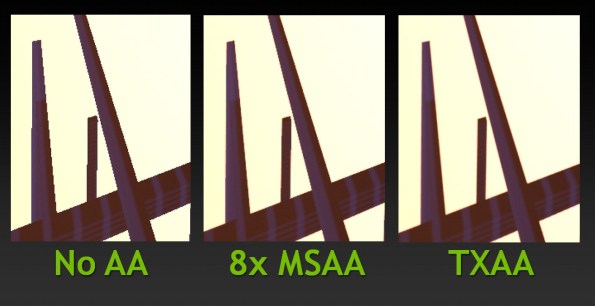NVIDIA TXAA Brings Movie CGI Rendering To PC Games
The Secret World & TXAA
Nvidia's Kepler packs a number of efficiency and performance improvements, but one of the GPU's major features has been locked away until now. When the company launched their new GPU core earlier this year, Nvidia debuted a new type of anti-aliasing it dubbed TXAA. Unlike other types of AA, which can often be forced on in the driver and applied to any game, TXAA required specific application support. Funcom's new MMO, The Secret World, was patched last week to add TXAA and we took the game out for a spin to see what it looks like.
Nvidia is still keeping most of the details of TXAA under wraps, but GeForce.com offers this explanation:
The "temporal filter Nvidia refers to is a different way of achieving the goals of standard spatial anti-aliasing.TXAA starts with an MSAA implementation, but then averages edge values across multiple frames rather than blowing them up to ultra-high resolutions. That's why Nvidia states that the technology looks better in motion -- static screenshots can't accurately capture the blending that occurs when a character is on the move.
The only anti-aliasing modes available in The Secret World are FXAA (in regular and high quality flavors) and 2x/4x TXAA. It's possible to force certain anti-aliasing methods through the use of Nvidia Inspector, but we stuck to the basic options available in-game. Because the performance hit from enabling FXAA is virtually nil, we skipped testing the standard mode and went straight to HQ. Screenshots below illustrate the three settings.
Key jagged spots and areas of interest in this first set of images include:
4x TXAA significantly improves the scene with only a modest frame rate hit. Here's the bicycle in all three modes, at 300% zoom.
TXAA does introduce a bit of blur, but it's less than what you'd see from a 4x supersampling implementation. Nvidia has stated that one of the benefits of TXAA is that it duplicates how Hollywood films use AA in rendered scenes. The Secret World doesn't exactly jump out and scream Inception, but the new anti-aliasing method is designed to produce more realistic images rather than overly sharp digital scenery.
Nvidia recommends evaluating the technology in motion, so hit next to see a video comparison.
What is TXAA?
Nvidia is still keeping most of the details of TXAA under wraps, but GeForce.com offers this explanation:
TXAA is a combination of hardware anti-aliasing, a custom anti-aliasing resolve, and a temporal filter. To filter pixels, TXAA uses a contribution of samples both inside and outside of the pixel in conjunction with samples from prior frames, to offer the highest quality filtering possible. In motion, TXAA approaches the quality of other high end, professional anti-aliasing algorithms, though the higher quality filtering used by TXAA does result in a softer image compared to the lower quality filtering of traditional MSAA.Despite their similar names, TXAA is not a form of FXAA (AMD calls its version MLAA). Fast approXimate Anti-Aliasing creates an pseudo-anti-aliasing effect by applying a post-processing edge-detection filter that blurs line edges. Intel invented and developed early iterations of what it referred to as morphological anti-aliasing, and Nvidia has improved on these early efforts, but FXAA isn't a true form of anti-aliasing.
The "temporal filter Nvidia refers to is a different way of achieving the goals of standard spatial anti-aliasing.TXAA starts with an MSAA implementation, but then averages edge values across multiple frames rather than blowing them up to ultra-high resolutions. That's why Nvidia states that the technology looks better in motion -- static screenshots can't accurately capture the blending that occurs when a character is on the move.
The only anti-aliasing modes available in The Secret World are FXAA (in regular and high quality flavors) and 2x/4x TXAA. It's possible to force certain anti-aliasing methods through the use of Nvidia Inspector, but we stuck to the basic options available in-game. Because the performance hit from enabling FXAA is virtually nil, we skipped testing the standard mode and went straight to HQ. Screenshots below illustrate the three settings.
Key jagged spots and areas of interest in this first set of images include:
- The bike
- The poster hanging above it
- The red car in the middle-right of the image
4x TXAA significantly improves the scene with only a modest frame rate hit. Here's the bicycle in all three modes, at 300% zoom.
TXAA does introduce a bit of blur, but it's less than what you'd see from a 4x supersampling implementation. Nvidia has stated that one of the benefits of TXAA is that it duplicates how Hollywood films use AA in rendered scenes. The Secret World doesn't exactly jump out and scream Inception, but the new anti-aliasing method is designed to produce more realistic images rather than overly sharp digital scenery.
Nvidia recommends evaluating the technology in motion, so hit next to see a video comparison.













